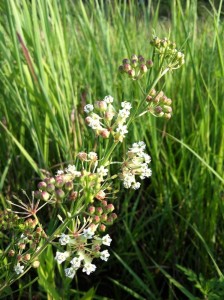The Milkweeds and Their Little Buddy
By Russell Rogers, volunteer at Stroud Preserve
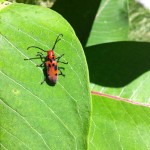
Mid-summer is upon us and with it are the milkweeds. Ever since I can remember I have had a fascination with milkweeds. They are most often large and showy, and in my opinion their flowers are amongst the most visually interesting flowers that can be found around here. The petals are flexed backwards as far as they can go, while the rest of the flower, the parts that most other plants keep hidden, is thrust forward into space. This gives it the appearance that the flower bud exploded and then was frozen in time right as it was about to fly into pieces. To add to its strange appearance, the parts of the flower that are extended forward are unique in that they consist of hoods and horns. It truly has the appearance of something from another world.
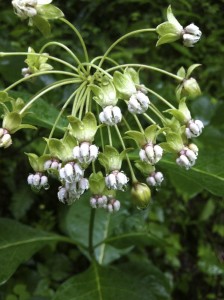
Poke milkweed showing the hoods and horns
Milkweeds can afford to be showy as their milky sap is poisonous to most animals. Insects that feed on the plant are also brightly colored. A statement to the effect of “look, but don’t eat.” A well-known example of an insect that feeds on milkweed is the caterpillar of the monarch butterfly. However, the insect that caught my eye was a little red and black longhorn beetle called Tetraopes tetrophothalmus, or simply the red milkweed beetle. They are interesting in of themselves as the antennae completely bisects their eyes, creating two sets of compound eyes. Thus the name Tetra “four” opes “eyes.”
As an ecologist I try to make observations of the natural world without injecting my own biases and assumptions. That said, my assumption about the milkweed and its little buddy, as I call it, was that they held some type of symbiotic relationship. Symbiotic meaning that they benefit from each other’s presence.
A little research showed that there may, in fact, be a symbiotic relationship, albeit, not between the beetle and the milkweed, but instead, between the beetle and the grasses that grow next to the milkweeds. As it turns out, the beetles only lay their eggs on the stems of dried grasses that grow immediately adjacent to the milkweed plant. The eggs hatch and the larvae drop off and burrow into the soil where they feed only on the roots of the milkweed plant. The larvae pupate in to adult beetles and continue to feed on the milkweed. All of this feeding upon the milkweed by the beetle ultimately inhibits the milkweed’s growth, in turn making more room for grasses to grow.
While the sap of the milkweed plant can be a culinary hazard, the nectar is not and attracts a wide assortment of butterflies and other interesting insects. If you would like to see these strange and wonderful plants and the insects that they attract, the Stroud Preserve is a great place to do so as there are at least five species of milkweeds that call the preserve home. Look for the poke milkweed (Asclepias exaltata) pictured above in moist shaded woods. Swamp milkweed (A. incarnata), common milkweed (A. syriaca), and butterfly-weed (A. tuberosa) can be found in the open fields throughout the preserve. Lastly, look for the rare whorled milkweed (A. verticillata) in and around the serpentine barrens. (The whorled milkweed is quite common at the Willisbrook Preserve, near Malvern).
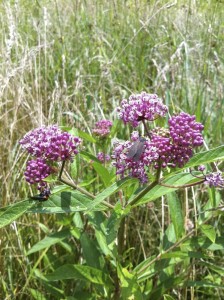
Swamp milkweed (Asclepias incarnata)
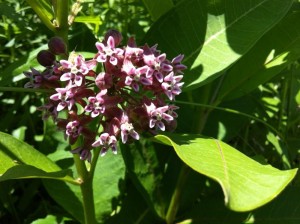
Common milkweed (Asclepias syriaca)
![Butterfly-weed (Asclepias tuberosa)] by Russell Rogers](https://natlands.org/wp-content/uploads/2013/08/Butterfly-weed-Asclepias-tuberosa-by-Russell-Rogers-224x300.jpg)
Butterfly-weed (Asclepias tuberosa)
